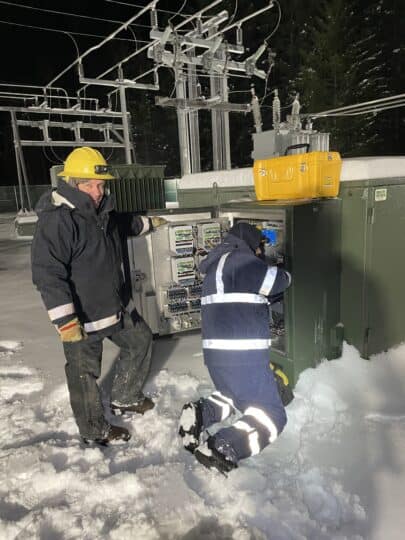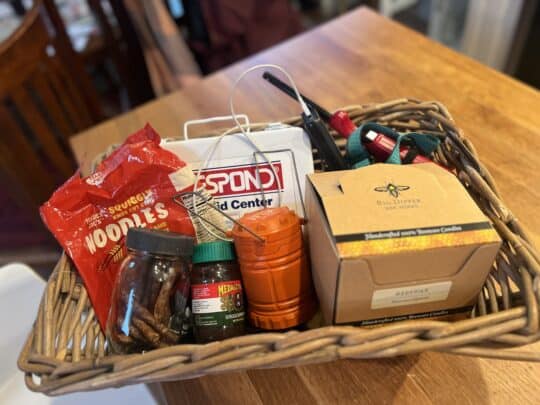Navigating Outages: From the Warehouse to your home
Navigating Outages
From the Warehouse to your home
Many of us rely on power for the essential functions of our day-to-day lives. Electricity powers our cellphones, laptops, heating systems, lights, cooking appliances and many other everyday items.
When the power goes out, it can feel like regular life comes to a standstill, and survival mode kicks in. It can be frustrating to wait for power to come back so business as usual can continue. Even with Orcas Power & Light Cooperative crews working as quickly as possible, some outages are more complex to assess and repair.
Behind the Scenes of an Outage
When an outage alert comes through the system, the crew gets a call from the dispatch system. Whoever is on call at the time goes to the warehouse to assess the outage information.

“We look at the information and decide the necessary equipment,” says Orcas Island Journeyman Lineworker Matt Minnis. “Then we gather what we need to repair the outage.”
Gathering the equipment is just the beginning. Once at the site, the crew has to take different measures to locate the fault and deenergize the line, depending on whether the outage is underground or overhead.
In the case of an underground outage, a machine called a thumper is used to find the exact section of the line where the damage has occurred. The machine emits a low thump sound every 10 seconds or so.
“That’s all you hear,” Matt says. “If there’s traffic or wind, you’re on your hands and knees trying to hear it— sometimes in the mud or snow.”

Overhead outages are equally complex, requiring use of bucket trucks or climbing a pole and isolating the area of damage.
Our island service territory is unique, especially when it comes to the duties of our crew. At most utilities on the mainland, there is a separate serviceworker who has a bucket truck and can go around locating faults before contacting the crew. The OPALCO crew takes on that work themselves and have learned to wear many different hats—including their hard hats—as they navigate repairing outages in the islands.
The crew works in unpredictable weather and during late nights to get power back to our membership as quickly as possible. Matt and the rest of the crew encourage members to look for updates on the co-op’s social media platforms, its outage page or through the outage phone line rather than stopping by a site in person.
When members show up on-site to ask for updates from the crew, all work must halt for safety reasons. There could be significant safety risks for anyone near the site, especially for members without protective equipment. If members stay home and use the other resources, crews are more able to focus on restoring power to all members as efficiently as possible.
To report an outage or get updates, call 360-376-3500, log in to your SmartHub account or visit www.opalco.com/outages.
Staying prepared is one of the best ways for an unplanned outage to go smoothly in your home. We’re here to help with that as we move into the colder months and storm season. Here are some tips to help you navigate any unplanned outages this year:
Know how to report outages. Outage reporting is essential in helping us gather information on what areas of the community are affected and allows our crews to respond more efficiently. Call 360-376-3500 or log in to your SmartHub account to report an outage.
Check in with your neighbors to see if they are out of power as well. Sometimes, if you’re the only one out, it’s your breaker. Monitor the status of outages with the most up-to-date information on our outage map at www.opalco.com/outages.
Prepare before a storm. Charge all essential devices, power banks, electric vehicles, etc., in the days/hours leading up to a big storm.
• Install surge protection or unplug sensitive electronics to protect them in case of an outage.
• Place flashlights in handy locations.
• Keep a battery-powered phone or radio in the house for emergencies.
• Keep important phone numbers near the phone (doctors, neighbors, relatives, outage buddies).
• Know where to find each utility shutoff and how to shut each one off.
• Keep at least half a tank of fuel in your car in the days before a storm (gas stations rely on electricity to power pumps).
• If you have an electric garage door, make sure you know how to open it manually.

Assemble your outage kit. Aim to have enough supplies on hand to get through a three- to five-day outage just in case. Store these items in a backpack, bucket or bin for easy transportation if needed.
• Drinking water and canned/nonperishable food
• Blankets, sweaters, warm socks
• Flashlights, candles, battery-operated lanterns
• Fully charged power banks for emergency devices
• Battery-operated clock/radio and phone
• Extra batteries
• First-aid supplies
• Electricity-free entertainment (books, puzzles, cards and board games)
• Three to five days of pet supplies for your furry family members
While outages are never convenient, proper preparation and awareness make getting through one a whole lot easier. These basics can be a great place to start.
■
Visit www.opalco.com/outages-safety/ preparation for more tips on preparing for outages and to download a storm checklist.



